Then vs Now: The Changing Landscape of Indigenous Healing
By Sheridan Teitzel - 2024 Monica Clare Research Fellow | 12 June 2025
Guest blogger: Sheridan Teitzel - 2024 Monica Clare Research Fellow.
Cultural contributors: Richard Barkley & Richard Ornyengia
Community review: Fiona Wirrer-George, Constance Bandicootcha, Richard Barkley, and Richard Ornyengia
Then vs Now: The Changing Landscape of Indigenous Healing
Throughout this project, we explored how Indigenous notions of health, sickness, and healing were understood by the various clan groups in Western Cape York. The research indicates that these concepts were embedded in kinship, environment, and Indigenous traditional Lore (protocols and knowledge).
The first blog “Nature’s Kin” discussed that for Indigenous people in Western Cape York, country is an extension of the self and therefore, harming the land is akin to harming the people and vice versa. The findings from this phase indicate that health is achieved and maintained through a holistic lifestyle that integrates spirit, health, kinship, environment, and cultural Lore into a unified approach to physical and spiritual well-being. Healing methodologies were categorised as: preventative, functional, general, crisis, and spiritual. These categories demonstrated how physical health and spiritual balance are linked, for example, routine preventative care is inseparable from custodianship of land and kin, while crisis responses and spiritual interventions draw on plant remedies, specialised practices, and kinship obligation.
The second blog “Guided by Lore” focused on the role of totemic dreaming and cultural lore in healing practices. It described how each clan and family in Wik society has specific obligations given by ancestral totemic beings, which structure their social, ceremonial, and healing responsibilities. In the traditional Wik worldview, sickness is never random, and is often seen as arising from environmental factors, kinship obligations, or breaches of cultural lore. Traditional healers, known as Noyan, operate in a dual physical-spiritual capacity and derive their abilities from totemic spirits (notably the Rainbow Serpent/Taipan) through initiation rituals.
In blog two, we found that ethnobotanical research by Sarah E. Edwards in Aurukun recorded nearly 200 medicinal plants used by the Wik peoples. Unfortunately, we found that only a dozen or so remedies are routinely used today due to a variety of factors. Nanny Marie Kalkiyorta, a respected song woman, voiced her concern about the erosion of cultural knowledge, especially in relation to ceremonial singing. As a custodian of traditional songs and practices, she regularly performs for surrounding clan groups and families who no longer perform the songs themselves. This growing reliance on a small number of knowledge holders demonstrates the gaps resulting from cultural loss and the obligations carried by those who still hold the knowledge. In our conversations, we discussed how modern pressures have impacted on the intergenerational transfer of cultural knowledge and identified systemic failures in the way western systems engage with Indigenous communities and people.
This phase identified five underlying value systems that influence health and inform healing practices including: duality, environment, relationality, custodianship, and animism. Additionally, it became evident that traditional healing practices generally differ from other medicinal frameworks in that Indigenous peoples primarily relied on ‘living’ as opposed to ‘dead’ or dried plants. Extracts of plants were either consumed or applied directly or by infusing with both cold and heated water. There was a strong emphasis on availability, seasonality, and land ownership that dictated the types of plant medicines that were utlised.
Living in Two Worlds: How Modern Demands Impact on Cultural Obligations
As Indigenous people living in a modern world, there is often a practical need to participate in western systems, whether that is education, traditional owner governance, and/or employment. Unfortunately, these systems can fail to embed Indigenous value systems at a fundamental level, resulting in a persistent mismatch between what Indigenous people recognise as culturally meaningful and what external institutions are prepared to support or resource.
As we have found, cultural practices were traditionally grounded in respect, reciprocity, and collective wellbeing. For example, Kalkiyorta (2025) explains that during sorry business, certain kin became “poison” to particular practices, foods, and plants, a protocol that traditionally created space for grieving family members (Personal Communication). This practice is not just encouraged, it is mandatory and failing to abide by these 'preventive’ cultural protocols result in an imbalance that may or may not trigger spiritual and physiological illness. The broader kinship network would then gather to provide for the family, preparing food, weaving, hunting, and conducting ceremony, knowing that in time, the same care would be extended to them. This was a relational economy, based on a form of exchange that sustained a lifestyle in accordance with cultural value systems, particularly reciprocity. Today, however, Indigenous peoples are expected to operate within a dual reality: sustaining cultural obligations while also navigating a capitalist economy that requires money to pay rent, buy food, and support family. Without adequate and culturally appropriate pathways for remuneration, many are forced to shift their focus towards income-generating activities that do not always align with cultural preservation. Additionally, when western systems require cultural engagement (whether ceremonial, experiential, or consultative), they are often offered compensation that fails to reflect the time, depth, and responsibility involved. A $50 gift card cannot meaningfully replace the role of kinship-based reciprocity, nor can it sustain a family. This unequal exchange creates a feeling of exploitation that causes disengagement from the process of western/cultural integration, which requires a baseline of respect to facilitate the successful embedding of culture within western systems. Without this respect, culture naturally becomes closed to outsiders, which appears to be occurring more among the younger knowledge holders, and the two systems remain strongly opposed, forcing indigenous people to fragment their practices and lifestyles.
Linking this back to the project, economic pressure is accelerating the erosion of cultural practice, and this is not due to a lack of interest, but as a result of ongoing systemic neglect. While cultural strength and resilience remain, the absence of meaningful structural support continues to undermine its continuity. However, when approached with integrity, these moments of exchange, such as cultural research, consultation, ceremony, or performance, can create very real opportunities, affirm the value of culture and knowledge keepers, and support its continuation into future generations.
Despite the significant public funding directed towards Indigenous communities, only a small fraction is used to cultivate and remunerate Indigenous knowledge systems (and their keepers) in a way that ensures cultural sustainability. Without this structural change, efforts to “embed culture” will continue to fall short and rely on the dedication and unpaid (or underpaid) labour of a handful of individuals.
Healing in Practice: Insights from Key Knowledge Holders
For the senior knowledge holders in the Western Cape, the relationship with Country is one that is lived as opposed to an abstract or symbolic concept. True continuity requires that the transition continues in this matter.
As Richard Barkley (2025) explained his country is an extension of himself, and the country is his home, his school, and his hospital (Personal Communication). Unfortunately, over time, the daily use of bush medicine and cultural practices has changed, caused by disruption, fear, and the demands of modern living. What was once practiced in everyday life is now often held by only a few and used in specific contexts like ceremony or illness and the gap between generations appears to be widening. The following section explores the current beliefs and practices of the key project contributors, offering insight into how knowledge is maintained, adapted, or at risk.
As the primary project contributor, Richard Barkley referenced several dozen plants (and counting) that span medicine, ceremonial, and edible plants. Barkley (2025) stated that he will regularly utilise nearly all the plants identified and demonstrated a preference for traditional foods and medicine over western sources. Richard stated that country was not only his hospital, but both his home and his school, he went on to explain that when he is within four walls, he feels trapped. He regularly extended on this understanding by explaining that country is an extension of self – specifically the lands to which he is custodian to. For Richard, speaking for Country is a sacred duty. It is not about titles but about protection and care. A key focus for Richard is the preservation of cultural knowledge, not just for knowledge's sake, but for the continuation of protocols and appropriate value systems (Personal Communication).
Among other senior men such as Richard Ornengaia and Lyal Kawangka (2025), the use of plant knowledge tends to differ, and it is generally reserved for specific contexts such as ceremony, illness, or hunting. Their knowledge base includes around a dozen commonly used plants, though the depth of understanding behind each remains significant. Cultural distinctions are also emphasized, particularly the differences between timber and coastal peoples, who engage with different plants and methods according to their environments. Many practices are site-specific, tied to ancestry that determine the appropriate use and meaning of each plant. While cultural systems such as totemic identities are still recognised and respected, they are not always enacted in ways that they once were (Personal Communication).
While knowledge systems and practices are shared across both genders, the women in the project placed a strong emphasis on medicinal practices as healing, country as home to both humans and animals, women-specific practices specifically relating to pregnancy, and cultural continuity. Women, in particular, emphasized nurturing, healing, and continuity. The regular use of bush food and medicine is seen as essential for family wellbeing, and spiritual practices such as smoking and sweat (from male family members) are employed to protect both the body and the spirit. There is a strong concern for the transmission of knowledge to younger generations, driven not only by cultural responsibility but also by a deep relational understanding of Country (Kalkiyorta & Bandicootcha, 2025). For Dorothy Pootchemunka (2025), the maum maum vine holds particular importance; she attributes her good health to its regular use and continues to maintain it as part of her daily routine (Personal Communication).The women in this project regularly described Country not just as a physical place, but as home to people, animals, and ancestral spirits, reflecting a broader relational and spiritual ecology. Teaching occurs through stories, songs, dances, and observation and practice ensuring that children grow up understanding that “Country will look after you, if you look after it” (Kalkiyorta, 2025). There was a strong emphasis on cultural continuity with Dorothy Pootchemunka (2025) who jokingly stating that young people sometimes fear poisoning from bush medicine and may be reluctant to try certain remedies (Personal Communication). Marie Kalkiyorta (2025) explained that in terms of learning and holding songs, this process can take decades, and she herself did not start singing until she was in her 30s (Personal Communication).
Plants in Practice: Traditional vs Cultural Use
Messmate Tree (Stringybark)
Botanical Name: Eucalyptus tetrodonta F. Muell
Language Group: Wik: Yuk Ponth
The inner bark of this tree is used both practically and medicinally. Knowledge shared by Richard Barkley (2025) highlights its use in cleansing and revitalizing the body (Personal Communication). Culturally, the tree has been used in a wide range of applications. The bark is commonly used to make canoes and traditional shelters. It is also used in funerary practices, such as wrapping and transporting deceased persons to their homeland, and features in spiritual practices where the deceased were believed to guide the living. In Pormpuraaw Cultural uses for Plants, Mary Holroyd and Syd Bruce Shortjoe (Wik Iiyanh) explain “When they (the old people) walked they carried the body on top of them. They used it like a compass. The body would sometimes move and indicate which way to go. The head would point to danger, where the native police were looking for them. They could talk with that spirit.” (Pormpuraaw Art & Culture Centre, 2021).
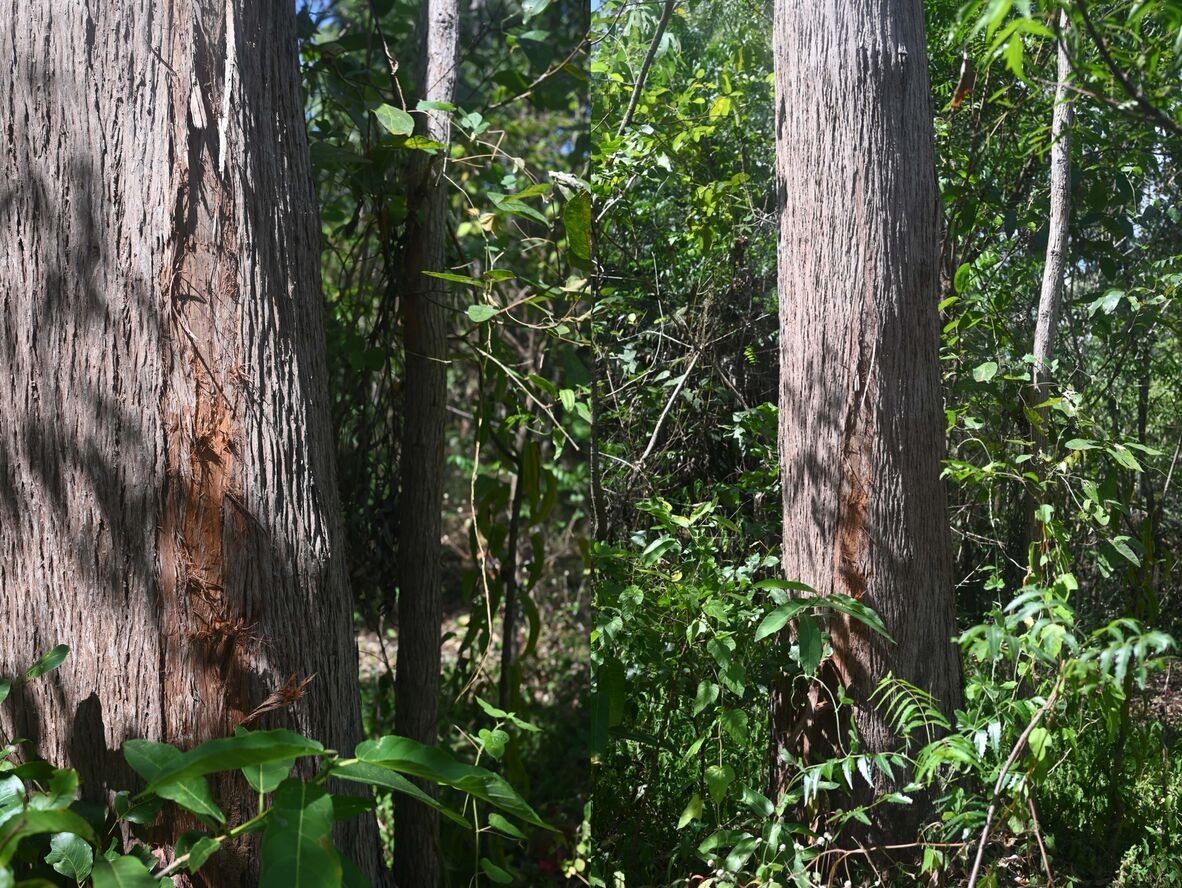
Recently harvested Messmate (inner bark).
Pandanus
Botanical Name: Pandanus spiralis R.Br
Language Group: Wik: Yuk Kunchan, Alngith & Thainakwith: Agarr.
Pandanus grows in coastal areas and near freshwater sources. Its nuts are consumed, while the leaves are primarily used in weaving. Historically, the inner bark was consumed as explained by Mary Holroyd (Pormpuraaw) who recalled observing her grandmother bake the top section on hot coals. Once it was cooked, it was split open and the stringy fibers removed. Eric Norman goes on to explain that the top portion of the trunk can also be used to heal wounds by crushing and applying directly to the wound (Pormpuraaw Art & Culture Centre, 2021).
In the Western Cape, the plant is also associated with the elements and kinship. For the Alngith, it is considered poison cousin to cyclones, and is connected to the story place at Gonbung, where the late Jean George (my great-grandmother) performed the cyclone dance. Today, Richard Barkley continues to use its leaves in headbands and armbands, due to its role as poison cousin to lightning in Thainakwith. Pandanus is one of the most actively utilised plants in the region, primarily for weaving, however it’s nuts are still consumed by local people such as Richard Barkley, who also utilised the leaves to create arm and head bands as protection (Wirrer-George & Barkley, 2025).
Pandanus Tree in Aurukun.
Termite Mounds
Termite mounds were historically used for a range of functional, spiritual, and medicinal purposes, including as a natural mineral supplement. Knowledge shared by Richard Barkley (who still actively utilises termite mounds) indicated their use in enhancing physical performance and sustaining energy during activities such as hunting and travelling. The top layer of the mounds removed, crushed into a fine powder, and consumed either with or without water. The darker, grey-coloured mound is particularly valued, as they are believed to contain higher mineral content than the red termite mounds. The mounds are also used practically as a natural oven and in sorcery (purri-purri) (Barkley, 2025).
Richard Barkley preparing termite mound dust for consumption. Photograph by Sheridan Teitzel, 2025.
Crows Fruit/Stinking Bullock Tree
Botanical Name: Terminalia Subacroptera
Language Group: Wik: Yuk Thankan
This tree is used for both its medicinal properties and as seasonal fruit. The leaves are used locally to treat skin conditions such as scabies and fungal infections. In surrounding clan groups, they are also boiled to make a tea used to relieve diarrhoea (Pormpuraaw Art & Culture Centre, 2021). The tree produces a sweet fruit toward the end of the wet season. Locally it is known as “Crows Fruit,” a name given because crows are known to swoop in and eat the fruit before the people have a chance to harvest it (Barkley & Ornyengaia, 2025). Knowledge of this plant remains common, however, active use for medicinal purposes is rare.
Richard Barkley with young Crow’s Fruit Tree. Photograph by Sheridan Teitzel, 2025.
Crows Fruit Tree in Napranum. Photograph by Sheridan Teitzel, 2025.
Iron Wood Tree
Botanical Name: Erythrophleum Chlorostachys
Language Group: Wik: Yak Yongk
The leaves of this plant are used in a variety of ceremonial and ritual practices, most notably in smoke ceremonies. These ceremonies are commonly performed during welcome ceremonies or following the passing of a person, particularly as part of a ‘house opening’ ceremony, which is performed to clear the space and help the departed return to their country. Young and fresh leaves are preferred, as they produce a thick smoke and a distinctive crackling sound when burned. The smoke is believed to cleanse spaces of negative spirits or lingering bad luck (Barkley, personal communication, 2025; Kawangka, personal communication, 2025; Ornyengaia, personal communication, 2025). Some records suggest that smoke may have also been used to induce sterility, however, the specific use of Erythrophleum chlorostachys for this purpose has not been conclusively verified (Pormpuraaw Art & Culture Centre, 2021; Beasley, 2018). Smoking ceremonies using this plant is still very common, with individuals performing personal smoking ceremonies when they feel unwell or clan and family groups performing smokings as part of house-openings or other ceremonies.
Richard Barkley holding the stem of an Ironwood sapling. Photograph by Sheridan Teitzel, 2025.
Ti-Tree
(Varius Species)
There are various types of ti-trees, each is used for a range of purposes spanning medicinal, culinary, ceremonial, and practical purposes. Some varieties have bark that is suitable for kap mari, whereas with others, their leaves are used for food seasoning, and certain varieties store a liquid in or near their trunk which used as an alternative water source when other water sources are scarce. Lyal Kawangka and Richard Ornyengaia (2025) shared that the ti-tree pictured below is still utilised regularly in Aurukun for kap mari and food seasonings (Personal Communication).
Nonda Plum
Botanical Name: Parinari Nonda
Language Group: Wik: May Pa’ol
The nonda plum has a range practical, medicinal, and nutritional uses. The bark was chewed to treat colds, while the fruit was consumed for general nourishment and to treat digestive issues. Excess fruit was dried, wrapped in paperbark, and buried for later use. In addition, older fruit could be heated and applied to the skin to treat various conditions. The plant’s twigs and saplings were made into brushes for extracting sugar bag (Pormpuraaw Art & Culture Centre, 2021).
All project contributors confirmed that the fruit is still activity consumed within the region, however, Kawangka and Ornyengaia stated that the consumption of the ‘nut milk’ has decreased since their youth. The milk is produced by crushing and soaking the seeds in water and is safe for anyone to drink. It was also used as a substitute for breast milk when necessary and is believed to support lactation in nursing mothers (Barkley, personal communication, 2025; Kawangka, personal communication, 2025; Ornyengaia, personal communication, 2025).
Nonda Plum located in Napranum. Photograph by Sheridan Teitzel, 2025.
Native Cotton/Kapok Tree
Botanical Name: Cochlospermum gillivraei Benth
Language Group: Wik: Yuk Uungkath
The inner bark is scraped and placed under the tongue as a natural anti-diuretic, helping to maintain hydration by reducing sweating and the need for urination during long periods of hunting or travelling. The seed pods contain a soft, cotton-like fiber, which was traditionally used to make padded beddings/cushions (Barkley, 2025). The roots of young trees are edible and were consumed as a seasonal food source. In surrounding clan groups, the leaves were used to clear the sinuses, often crushed or inhaled for their aromatic properties (Pormpuraaw Art & Culture Centre, 2021).
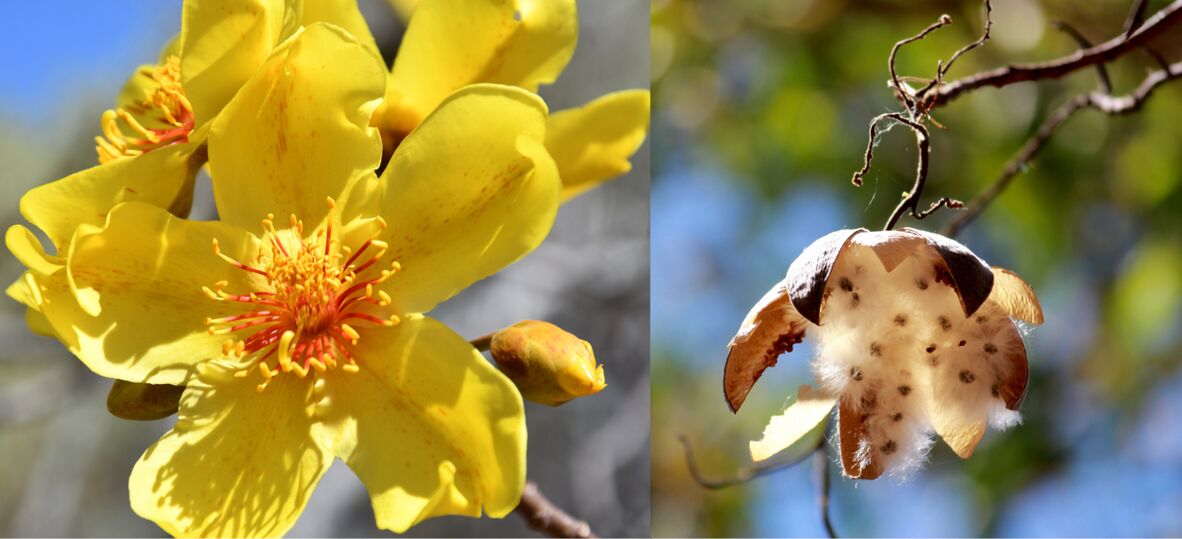
Flower and Seed Pod of the Native Kapok Tree.
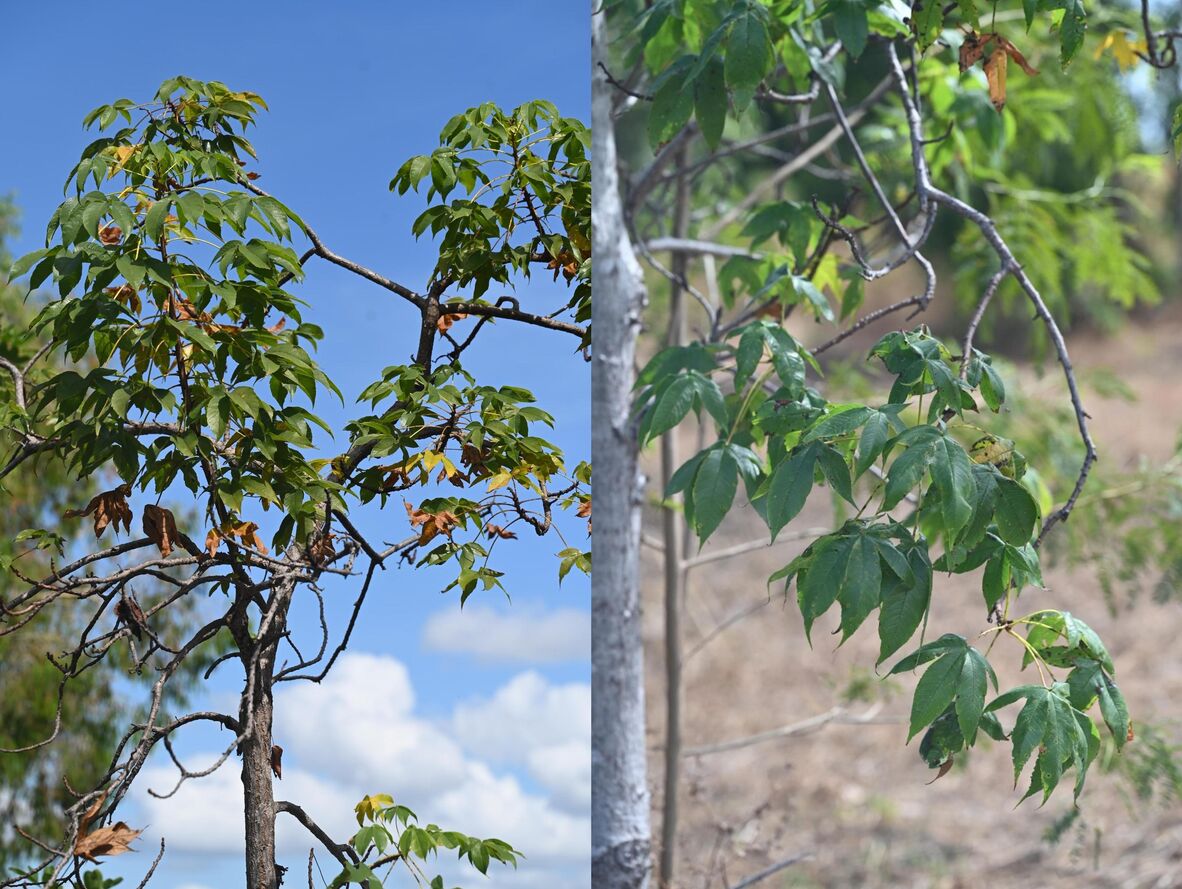
Native Cotton Tree in Weipa. Photograph by Sheridan Teitzel, 2025.
Common Name: Love Vine/Dodder Vine
Botanical Name: Cassytha filiformis
Language Group: Wik: MaumMaum (Moomam) & Thainakwith: Timtimy
This vine is currently the most utilised and prized medicinal plant in western Cape York. It is known for its wide range of medicinal and practical applications. Traditionally, it is used to treat jellyfish stings, with the gel of green, orange, and red vines applied directly to the affected area to reduce pain and inflammation. It is also used to treat infected eyes and promote general wellbeing. n Aurukun, it is believed to assist with cancer. Beyond its medicinal value, the plant also serves practical purposes as its fibers are used as rope for spears, shelter construction, and humpies, demonstrating its importance in both healing and everyday life on Country (Pormpuraaw Art & Culture Centre, 2021; Barkley, Personal Communication, 2025; Pootchemunka, Personal Communication, 2025).

Dorothy Pootchemunka preparing maum maum in Aurukun. Photograph by Sheridan Teitzel, 2025.
Milky Mangrove
Botanical Name: Excoaecaha agallocha L.
Language Group: Wik: Yuk Upan
This plant holds a specific place within the kinship system, where it is recognised as a poison cousin to stingray. It is traditionally used to treat stingray barb wounds, drawing on its symbolic and medicinal relationship to the animal. The milky sap is applied directly from the twig to the wound, however, the sap is extremely poisonous and is known to cause blindness if it comes into contact with the eyes (Pormpuraaw Art & Culture Centre, 2021; Kalkiyorta, Personal Communication, 2025).
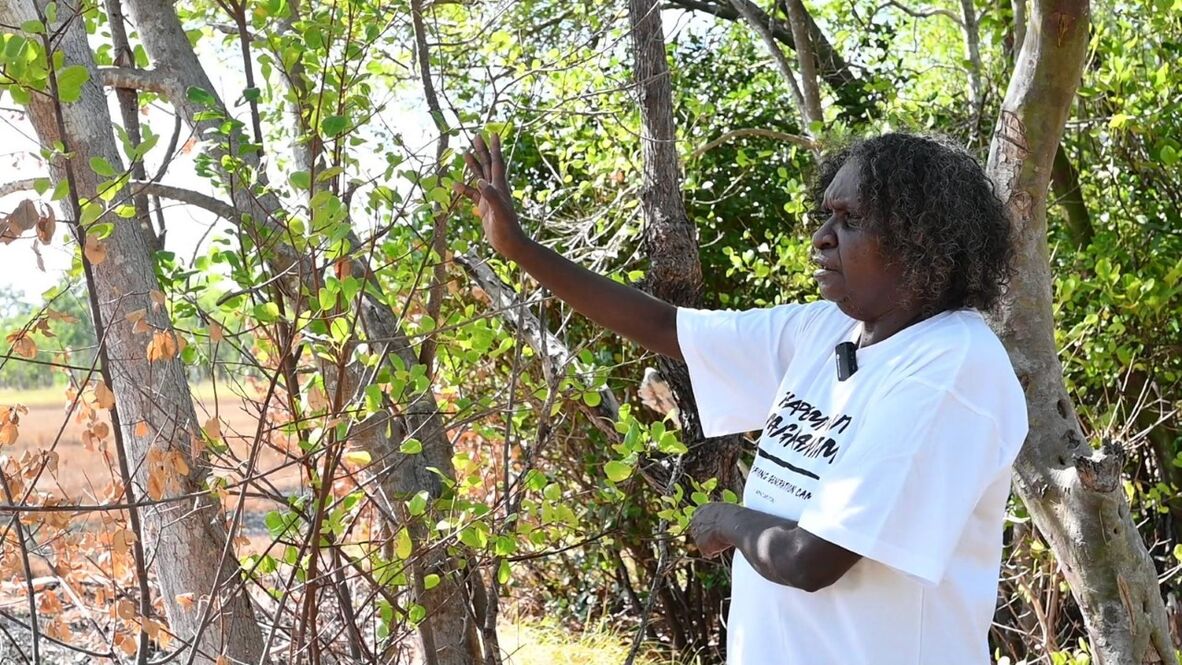
Marie Kalkiyorta identifying the Milky Mangrove Tree. Photograph by Sheridan Teitzel, 2025.
Milkwood Tree
Botanical Name: Alstonia Actinophylia
Language Group: Wik: Yuk Thanchal
This tree is used for both its practical uses and medicinal properties, though it must be handled with care. Barkley (2025) shared that the soft inner bark is rubbed directly onto the gums to treat gum disease and mouth ulcers, offering relief through direct application. The sap is sometimes used to promote lactation in nursing mothers, though the sap is considered to be poisonous and dangerous. Its use is highly specific and guided by cultural knowledge. It is currently utilised primarily for carving totemic and ceremonial artifacts (Personal Communication). Traditionally, the tree’s timber was also used to manufacture canoes. Certain parts of the plant are considered more dangerous than others and the smoke is harmful to the lungs, and the sap can cause blindness if it comes into contact with the eyes (Pormpuraaw Art & Culture Centre, 2021).
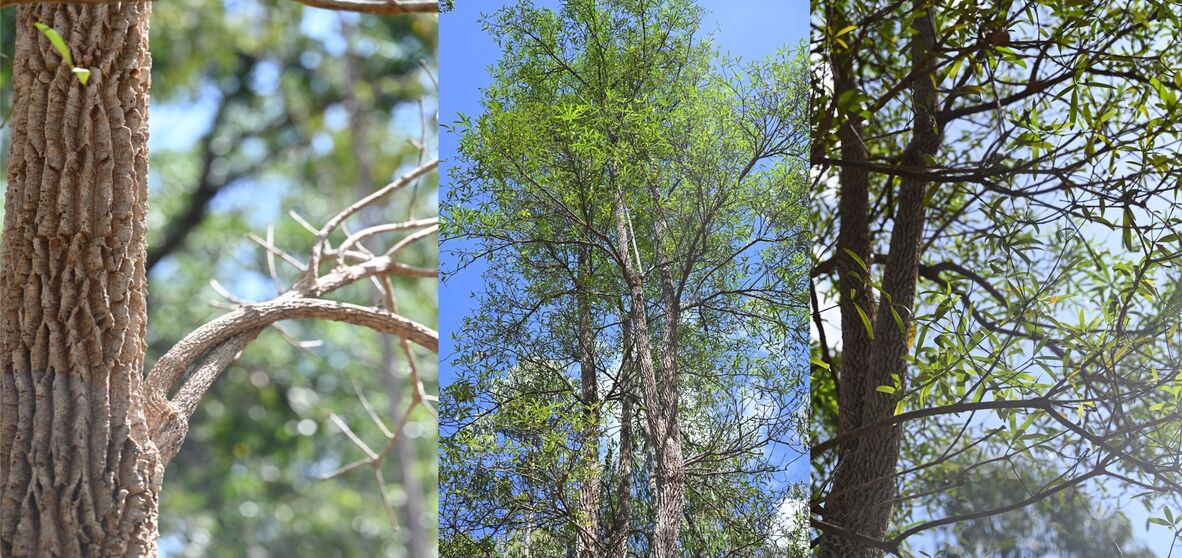
Milkwood Trees in Weipa. Photograph by Sheridan Teitzel, 2025.
Cabbage Palm Tree
Botanical Name: Corypha Utan
Language Group: Wik: Yuk Thuuth
This plant is known as a reliable water indicator, often found in areas where groundwater is present or nearby. The inner bark is consumed both as a bush food and for treating digestive issues (Barkley, 2025). The leaves are commonly used for weaving, particularly in the making of dilly bags (Kalkiyorta, Personal Communication, 2025; Pootchemunka, Personal Communication, 2025; Pormpuraaw Art & Culture Centre, 2021).
Cabbage Palm Tree in Weipa. Photograph by Sheridan Teitzel, 2025.
Ipomoea (Beach Morning Glory)
Botanical Name: Ipomoea pes-caprae (L.) R.Br.
Language Group: Kuuy Min-kut’n
This plant is widely recognised for its antibacterial properties and is used to treat a range of ailments. The leaves are boiled and applied to the skin to treat jellyfish stings, helping to reduce pain and inflammation. Heated leaves are also applied to swollen joints as a traditional remedy for pain and stiffness. Infusions and poultices made from the leaves are commonly used to treat wounds, sores, and general sickness and be applied directly to the skin or consumed (Bandicootcha, Personal Communication, 2025; Wirrer-George, Personal Communication, 2025; Pormpuraaw Art & Culture Centre, 2021).

Ipomoea captured in Weipa. Photograph by Sheridan Teitzel, 2025.
The digital stories recorded with Elders and community contributors from Cape York Peninsula will be added to State Library's collection, preserving traditional knowledge for future generations.
Sheridan Tietzel
www.arnya.com.au
The Monica Clare Research Fellowship is generously supported by The Siganto Foundation.
Read other blogs by Sheridan Teitzel
- Nature’s Kin: The Integral Role of Kinship in Indigenous Medicine
- Guided by Lore: The role of Kinship and Totemic Dreaming in Indigenous Systems of Healing
Read more blogs about Queensland's First Nations history by past Monica Clare Research Fellows.
Watch Sheridan's Research Reveals talk about her project below.
References
- Pormpuraaw Art & Culture Centre Inc. (2021). Pormpuraaw cultural uses for plants (2nd ed.). Pormpuraaw, QLD: Pormpuraaw Art & Culture Centre Inc.
- Beasley, J,. (2018), {Plants of Cape York, the Compact Guide),
- Barkley, R. (Napranum Elder, Thainakwith). (2025). Personal communication.
- Kalkiyorta, M. (Songwoman, Wik-Puutch). (2025). Personal communication.
- Pootchemunka, D. (Senior Aurukun Elder, Winchanum/Aplach). (2025). Personal communication.
- Bandicootcha, C. (Puutch Elder). (2025). Personal communication.
- Wirrer-George, F. (Alngith-Layngnith, Mbaiwum). (2025). Personal Communication.
- Kawangka, L. (Chairperson, Ngan Aak Kunch). (2025). Personal communication.
- Ornyengaia, R. (Wik-Way/Wanam). (2025). Personal communication.
Sheridan Tetizel's Research Reveals talk.
Comments
Your email address will not be published.
We welcome relevant, respectful comments.